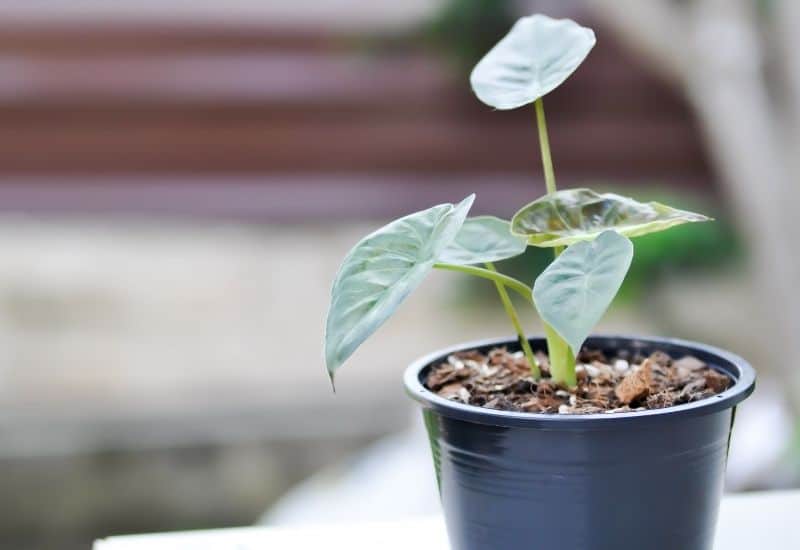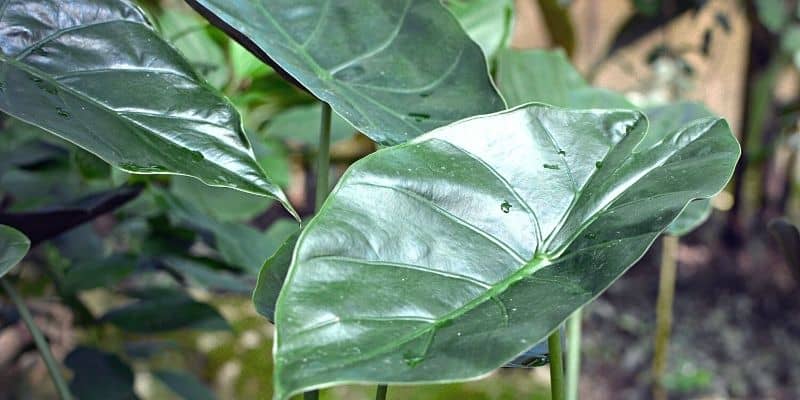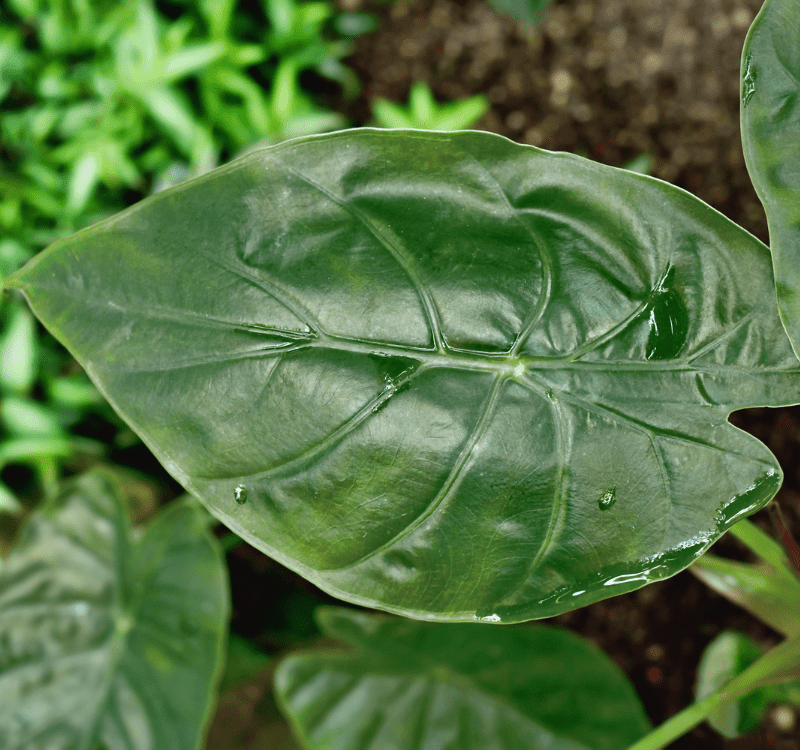Alocasia Wentii, or Hardy Elephant Ear, is known for its lush green leaves with purplish undersides clustered together. Hailing mainly from New Guinea, this herbaceous plant is a hybrid mix between Alocasia Ordora and Alocasia Gageana.
The low-maintenance Alocasia Wentii thrives in a warmer environment but can still maintain a healthy appearance in cold conditions.
Alocasia Wentii Care Guide Overview
- How To Plant (when & where)
- How To Grow (staking, watering, fertilizing, humidity, mulching)
- How To Trim And Prune
- How To Pot And Repot
- How To Propagate (when & how)
- And Pests and Diseases, Plant Species, Toxicity
Characteristics
- Scientific name: Alocasia Wentii
- Common names: Hardy Elephant Ear, Purple Umbrella, New Guinea Shield
- Origin: New Guinea; also found across regions of Asia and Australia.
- Indoor or Outdoor Plant: Commonly used as a houseplant. In warm, humid climates makes an excellent addition to outdoor landscaping.
- Height and Structure: 3 feet high, 3 feet wide. Leaves can grow to 1 foot long. Mid-size Elephant Ears, typically placed indoors, grow to about 1.5 feet.
- Temperature: Can sustain between 55F and 86F. Plant health will begin to deteriorate above 95F.
- Flower Color: Produces small, light-colored spathes.
How To Plant Hardy Elephant Ears

Planting Time
Alocasia Wentii is ideally planted in Spring or Summer during warmer temperatures. If potted, they should be brought indoors when temperatures begin to fall. They will not survive harsh winter weather. If subjected to moderate cold, they will remain dormant.
Once planted, whether indoors or outdoors, plants will take between three to eight weeks to sprout.
Light
Indirect sunlight will provide sufficient light for Elephant Ears. Direct sunlight causes these plants to burn. If placed indoors, a window with filtered brightness would be best. Artificial lights placed around the plant work as well if a window is not an option.
When using outdoors, indirect light is still the optimum choice. Placing in a pot on the corner of a balcony or patio works well. Keep in mind, insufficient light for the Alocasia Wentii will stunt its growth.
Soil
A soil that is moist and drains well is preferred for Alocasia Wentii. The mix is of particular importance because too much moisture will cause harm to the plant. A recommended mixture is one part soil, one part potting sand, and one part peat.
Another option is to use equal portions of household potting mix and cactus soil mix. Keeping track of water saturation is crucial.
How To Grow a Alocasia Wentii

Growth Habits
Hardy Elephant Ears grow in a clustering pattern. At their tallest, they grow up to three feet tall and wide. They grow at a relatively slow pace and stop growing during the winter months. The roots do like to spread, so side plants are possible from new bulbs.
Staking
Alocasia will lean toward whatever direction its light is coming. Staking may be used to keep the plant growing upright, although it is not generally necessary. Leaning is not an issue unless the stem is soft or broken. An unstable base indicates an underlying concern with the plant.
Watering
It is best to water this plant when the top two inches are dry. Overwatering will cause the soil to hold in too much moisture and lead to possible disease. Watering it evenly assures that moisture reaches all parts. In Winter, when the plant essentially stops growing, watering it less is acceptable. Under normal circumstances, watering once or twice a week is standard.
Fertilizing
Fertilizing is necessary every two to four weeks depending on the type of fertilizer used. Spring and Summer are when the Elephant Ear needs feeding the most. It isn’t necessary to fertilize it during colder months as this may lead to salt build-up and severe damage to the plant.
If the leaves start to become discolored, your Alocasia has been over-fertilized.
Humidity
Utilizing a humidifier or grouping plants together will help promote the minimum 60% humidity this Alocasia needs. Misting it often or placing a pebble tray nearby are also good ways to stimulate humidity.
If planning on misting for this tropical foliage, do not over mist. Excessive wetness could lead to unwanted pests or illness for the Hardy Elephant Ear. Wiping the mist off leaves when done is also recommended.
Mulching
Mulching is a great outdoor option to prevent the soil from drying up too quickly. It may also help counteract some of the effects of the cooler winter weather.
Trimming and Pruning
Alocasia Wentii may need cutting to maintain health or control its size. If old/yellow leaves are going to be removed, try to stay toward the bottom. New leaves typically sprout toward the top of the plant.
Cutting off diseased portions of a plant requires great care. Sterilizing garden equipment helps to prevent spreading more infections. Cut off any section of the plant that appears dead or old.
Potting and Repotting
Repotting is usually only needed when roots have become over-spread, or about once a year. Spring is the best time to repot if necessary. Well-draining, rich soil will help Hardy Elephant Ears grow the best in snug pots. Moving up 1 to 2 inches in pot size will allow plant growth and room for the root structure.
When repotting, make sure to disrupt the root structure as little as possible.
Propagation

These plants grow from rhizomes as a tuberous species. Baby plants reproduce off of a parent plant making it much easier to separate and grow new plants. This is not the type of plant to propagate using cuttings.
The division of the clumps formed at the roots is the principal method to create new, individual plants. One must be careful not to tear the roots, use a sterilized tool, and untangle them. Spring is the best time to propagate when the growing season has begun again.
Divide and Transplant
Have a container ready for the division, along with some soil. Once excess soil has been taken off from the Alocasia Wentii, you will see clumps in the roots, which can now separate. Separation is usually done with a sterilized knife or scissors.
The new plant should grow at a faster pace because it will already have a root system in place.
Once placed in a new container, place in an appropriately lit area and add water. Remember to avoid overwatering.
Pests and Diseases
A good habit to have is inspecting for pests when watering an Alocasia Wentii. The main offenders to be aware of are thrips and spider mites. They have been known to hide under the leaves or in crevices, so careful examination is needed.
If pests are observed on the plant, remove any leaves that have been affected. It’s also recommended to isolate the Hardy Elephant Ear so the infestation does not spread to other plants. Insecticidal spray or soap is used to remedy this issue.
Three conditions that can affect Alocasia Wentii are:
- Root-rot- caused by excessive watering. Water the plant only when the top two inches seem dry.
- Salt Buildup- caused by excessive salts or minerals from unbalanced fertilizers, also from using chlorinated water. Lukewarm or distilled water is preferred.
- Drooping Leaves- caused by incorrect watering, lack of nutrients, pests, or incorrect amount of sunlight. Make sure watering and feeding directions are followed.
Plant Species
The Alocasia Wentii is a hybrid mixture of two plants- Alocasia Ordora and Alocasia Gageana:
- Alocasia Ordora- This plant is known for its large paddle-shaped leaves that point upright, making room for surrounding plants below.
- Alocasia Gageana- The Dwarf Upright Elephant Ear is shorter in height than the Alocasia Ordora, but still maintains leaves up to 18 inches long.
Toxicity
Alocasia Wentii is considered toxic to humans and animals. It contains calcium oxalate crystals that, if ingested, create respiratory issues and inflammation.
Final Thoughts
The Hardy Elephant Ear is not for a novice gardener. Someone who is willing to spend extra time taking care of plants and wants a beautiful one to look at should pick the Alocasia Wentii. These plants are not low maintenance but are worth it if the effort is there.


